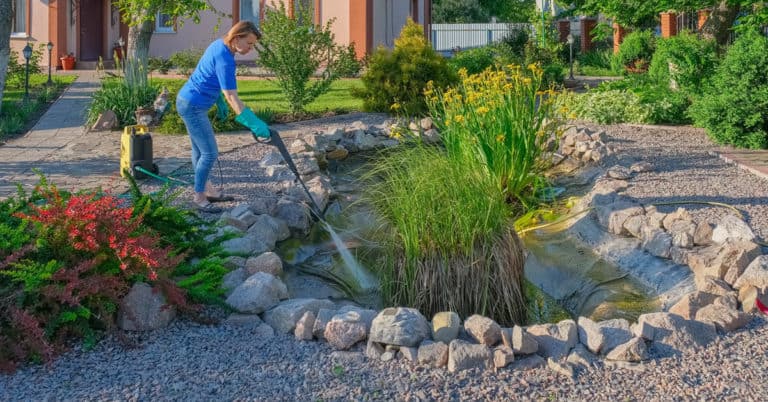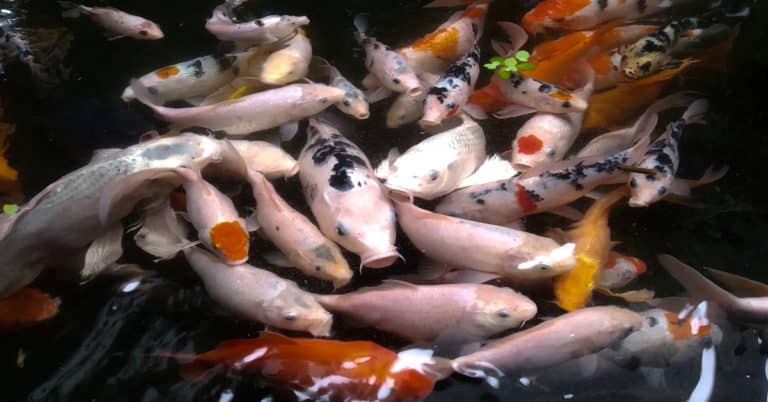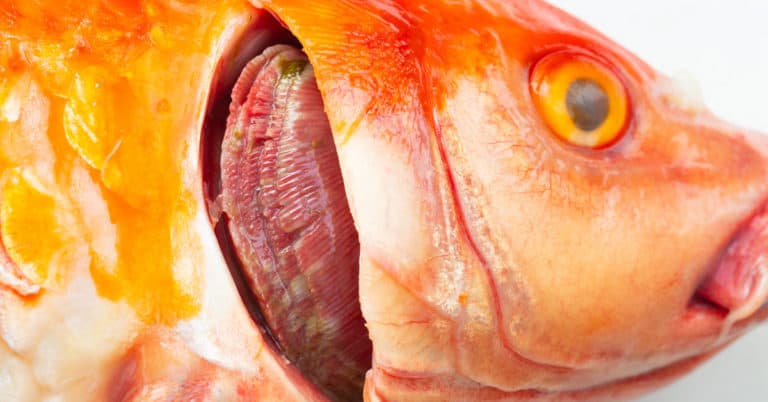Introducing a sick fish into our koi pond makes it more likely that our other pond fish will get sick, but it’s not the only cause. Bacterial infection in koi fish can crop up due to unhealthy living conditions.
I’m a pond hobbyist, but I back my approach to maintenance with research. Before I share information on my site, I try it in my pond to ensure the advice is effective.
Maintaining our pond to certain standards can decrease the chances of our koi fish getting sick.
In this article we'll learn about:
Aeromonas hydrophila is the most common bacteria found in all pond water. Yes, even if we keep our pump, filter, and water as clean as possible, there are still Aeromonas in the pond, what a nasty bacteria. If our fish are healthy and don’t experience stress, motile Aeromonas most likely won’t make them sick.
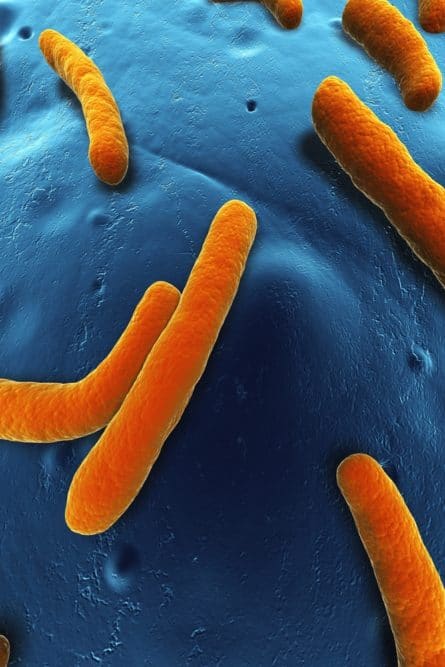
The situation is similar to humans catching viruses. Viruses are always around, but when we’re well-rested and healthy, our immune system can fight off the virus.
The same happens with Aeromonas in the water. Keep the water quality high, don’t overcrowd the pond, and keep the pond protected from predators. Feed them a nutritious diet and ensure they have enough to eat.
Having Aeromonas hydrophila in our water doesn’t mean that there’s a high level of them. We can maintain our pond to a degree that Aeromonas don’t pose a threat to our fish. A low level of Aeromonas in the water ensures the fish waste disintegrates promptly.
If our fish are weak, stressed, or immunocompromised, Aeromonas can cause ulcers. The spot initially looks like a white pimple on our fish’s body. When left untreated, it develops into an open sore. The ulcer can lead to scars, loss of scales, further infection, and death. Better take those bad boys seriously.
One fish with ulcers caused by Aeromonas doesn’t necessarily mean that other koi will also suffer. As previously mentioned, the bacteria is always present in the water and won’t harm fish until their immune system isn’t strong enough to protect them.
Aeromonas hydrophila is prevalent when the water warms up in early spring. This increase in temperature helps the bacteria flourish. In cold weather, koi’s systems slow down, and this includes their immune system. Therefore, as Aeromonas are active, koi fish aren’t functioning up to par. This leaves them open to infection.
We can work to prevent this risk by feeding our koi probiotic-enhanced foods to boost their immune systems. Note that the FDA has restricted the sale of medicated food for animals and fish, so don’t get conned into buying such a product.
If space isn’t an issue, we could also bring our koi and goldfish inside during cold months. Keep them in a tank that’s large enough and maintain the water temperature so they’ll feel comfortable. Basically a fish mansion.
While Aeromonas are the most common bacteria found in ponds, it’s not the only one that can cause infections. Infections will look different depending on the bacterium that caused them. Koi will consume some bacteria from the water as they swim.
Bacteria can also harm koi externally. It can adhere to scales in an attempt to find a way into the body. We might notice this showing up as:
Some diseases reproduce quickly, so it’s crucial to keep an eye on our pond’s overall health.
Bacteria can either attack all fish in the pond through the water or only take advantage of koi that are already weak. By keeping our fish in good health, we’ll reduce our risk of them encountering these bacterial infections.
Some of the most common infections harming koi are erythrodermatitis, koi herpesvirus, and exophthalmos. These diseases can damage fish internally and externally. And I thought human diseases were bad.
Erythrodermatitis is also known as Spring Viraemia, SVC, and Viraemia. It’s prevalent in cooler temperatures and shows as red spots on the fins, a swollen abdomen, and lethargic behavior. Even after a fish survives the disease, they’re able to pass it along to others.
The disease spreads through the waste of infected fish. Blood-sucking parasites in and around our pond can also transmit the virus from fish to fish.
Because there’s no set medication for erythrodermatitis, it’s best to give our koi fish vitamin-enriched food. If we’re able to control water temperature, keeping it warmer can also prevent erythrodermatitis.
On the plus side, a fish that survives erythrodermatitis develops immunity against the virus. This is especially positive since there are no vaccines for the disease.
This koi fish disease is also known as carp pox. It’s a very infectious disease, even if our pond is clean, not overcrowded, and safe from predators. The virus reproduces in cooler water and only affects koi, so if we have goldfish and other fish in our pond, they’ll likely stay safe.
The virus spreads from contact with infected fish or the fluids they secrete. Even mud, water, and other surfaces that come in contact with infected carriers can transmit the disease.
Carp pox is a rapid killer, with death happening as quickly as 24 to 48 hours from onset. To catch herpesvirus as it starts, we need to keep an eye on our koi when the water temperature is in the 50 to 80℉ range.
First, we’ll notice changes in their mucous membranes, which leads to severe gill decay. Their eyes might also sink into their head. The gill decay makes the koi struggle for air, so we’re likely to see them at the surface of the pond, gasping for breath.
Even if a koi survives herpes virus, they’ll stay infectious for the rest of their lives. Therefore, the only viable solution to prevent spreading is to eliminate the entire population of koi that could have the infection.
When we buy new koi, ask the supplier if there have been any diseases in the population. There are lab tests that will show a clean bill of health, so we can ask for copies of the results. Even with a negative carp pox test, we’ll still want to quarantine any new koi for up to 30 days before adding them to our pond. Another quarantine? This has to be a joke.
It isn’t by the way.
Because carp pox is so widespread in the United States, many vets and local labs can run tests to rule out herpes virus before we integrate new koi into our pond.
We might know this fish disease by the casual name of popeyes because one or both eyes will pop out of the fish’s head. Though it’s easy to see the symptoms of exophthalmos, it’s harder to pinpoint exactly how it’s caused.
One theory is water quality. If we notice exophthalmos in our fish, check the pH, ammonium, nitrate, and nitrite levels in our pond water. Koi pond pH levels should fall between 6.0 and 8.0. If they’re off, we want to balance them by adding baking soda to increase the pH or sodium bisulfate to lower the levels.
Another theory of the root cause of exophthalmos is vitamin deficiency. If our koi and goldfish aren’t getting the nutrients they need, their body might overcompensate and cause popeyes. Feeding them food with added vitamins is a great way to combat this possibility. We also need to check and ensure we’re using food from open containers before it goes bad.
We might notice that new fish experience exophthalmos when they’re added to our pond. In this case, it usually means that they’re stressed from the change. Just remember moving from home, can’t judge them.
Koi can often make a full recovery in about a week as they acclimate to the pond, as long as all other conditions are favorable.
If only a few koi in our pond seem affected by exophthalmos, we can conclude that it’s most likely a bacterial infection, which isn’t widespread throughout our pond right away. This gives us a chance to quarantine the infected fish and nurse them back to health in a separate tank to save our other koi.
The signs that our fish are sick aren’t always obvious. To identify koi disease, look for subtle changes in their behavior, like:
Noticing these behaviors in a fish means we can quarantine the affected fish so the disease won’t spread through our pond. Keeping the infected fish in a smaller, controlled tank will give them the chance to heal. This sounds awfully familiar, but true nonetheless, don’t get me wrong.
If the infections progress, we’ll see visual elements of symptoms that help us identify the precise disease. At that point, we can research possible treatments.
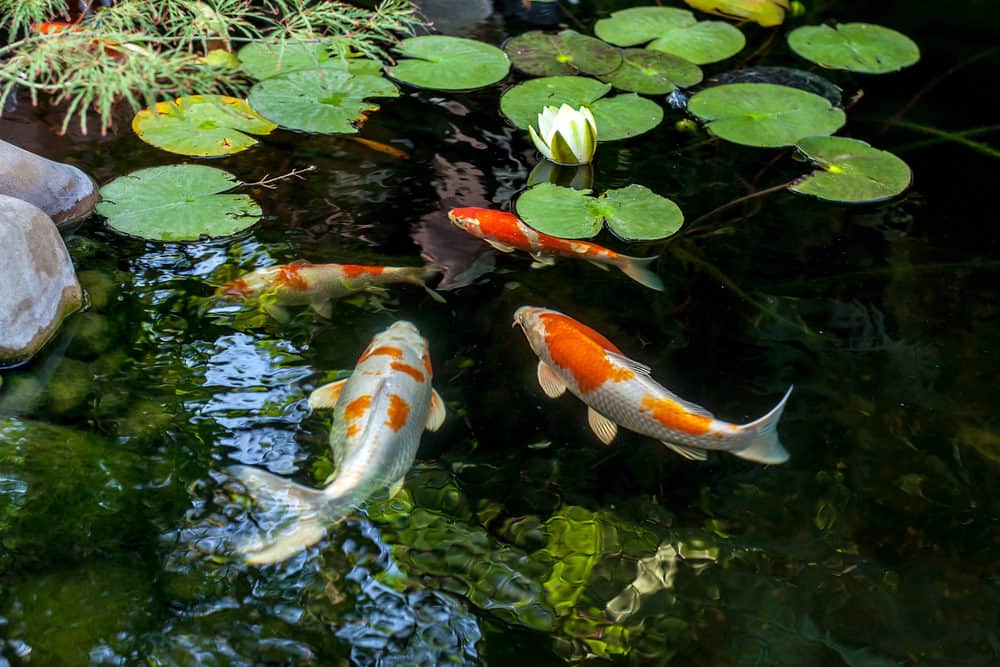
Depending on the type of bacterial infection, we might see symptoms like:
We can also check their heads for mouth fungus, cloudy eyes, or bulging eyes. Look over their bodies for signs of fungus, ulcers, or leeches. These outward signs might show that a virus is harming the fish internally, but they can also weaken the koi and make them more susceptible to infection.
We can swab open wounds on our koi and send the specimen to a lab for a diagnosis. After we get the results, we can take them to a veterinarian for an antibiotic. However, this is uncommon because bacterial infections are naturally recurring, and fish antibiotics aren’t prescribed repeatedly. Taking them continually might put our koi’s overall health at risk.
Koi are hardy fish, so if we buy a robust one and get it comfortably settled in our pond, it’s unlikely that it will get sick. However, we must keep our pond clean and safe to keep them healthy. Just like a pet, but even better...a Koi.
If we notice that our fish seems sick, then we need to treat the illness as soon as possible. This will boost our fish’s health and ensure their safety. Feeding our koi probiotic food is a safe way to boost their immune systems whether we see signs of infection or not.
Never jump into experimental treatments. Make sure we know what is plaguing our fish before we start trying everything to cure them. If we think water conditions are the culprit and begin messing with pH levels or water temperature, we could cause more harm than good.
When just one or several fish seem sick, we can quarantine them in a large tank and nurse them back to health. If most of the fish in our pond seem ill, it’s best to treat the whole ecosystem at once.
Approved treatments for bacterial infection in koi fish include:
Treatment is effective but should be our last effort when we have sick fish. Prevention is far more effective and isn’t hard to manage. It’s also healthier for the fish as well as our pond ecosystem.
A stressed fish is more likely to fall ill, unlike us humans, their methods for relaxation are different:
Prevention isn’t difficult if we stay on top of pond maintenance and follow safe practices. Each pond differs depending on our location as well as the fish and plants we have in our pond. I can’t give one set solution to maintaining our pond because levels are specific to our ecosystem.
In general, we should periodically test our water quality to ensure the pH levels are at the right balance. Make sure the temperature is ideal for the fish we own and doesn’t promote bacterial growth.
Regularly change water filters and make sure the pump is running efficiently. Filters are often overlooked when it comes to tracking the root of koi diseases. Debris gets caught in the filter and bacteria can grow unchecked. We can clean the filters in between replacements by flushing them away from the pond so the dirty water will wash away from the pond.
Take care when we’re adding new fish to our environment. We mustn’t introduce new fish if we’re worried that one of our original koi fish is battling an infection. This is the basic rule, don’t introduce people just after break up, same thing with fish.
Before we add new fish, quarantine them for at least 30 days. Keep them in a large tank or separate pond that’s far enough from our main pond where water won’t splash between the two.
If they have ideal results from the diagnostics lab, we don’t need to quarantine them for as long. Still, take the acclimation process slowly so the fish adapt to first the water temperature and then the overall setting of our pond. This reduces the stress they’d feel otherwise, which keeps them healthy and prevents their immune system from getting compromised.
Even after we integrate new koi into our pond, we still have work to do. We need to keep an eye on them to make sure that they’re adjusting well. If we notice any signs that could imply they have a bacterial infection, we can quickly pull them out for another quarantine.

